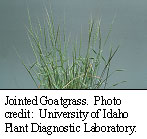
The Nez Perce Conservation District recognizes the importance of addressing noxious weeds, in order to preserve land, agricultural, and recreation values. Noxious weeds in the United States cause major environmental and economic damages. Nationwide, there are approximately 50,000 foreign species present, resulting in billions of dollars in damages to crops, costs in treatment, and other expenses. Approximately 42% of Threatened and Endangered species are at risk primarily because of non-indigenous species.
The effects of noxious weeds are varied, depending on the plant. For example, spotted knapweed has been shown to reduce elk winter range by 50-90 percent, affecting not only the elk but the hunters, guides, wildlife watchers and other industries dependent on wildlife. Noxious weeds displace native plant communities and reduce biodiversity. Left unchecked, they would result in an ecological disaster.
Successful weed control relies upon combinations of weed control practices called Integrated Weed Control Systems (IWCS), involving preventative, cultural, mechanical, biological, and chemical control of weeds. People are the key to preventative weed control. We can utilize practices such as weed-free crop seed, weed free manure and hay, clean harvesting and tillage equipment, and eliminating weed infestations in key areas to address these issues.
The District is an active participant in the Clearwater Basin Cooperative Weed Management Area. Through this group, the District obtains funding as well as technical expertise to address priority weed control concerns.